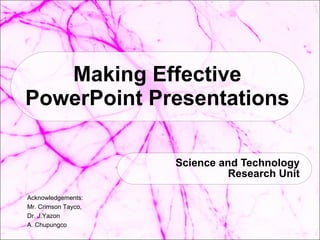STR2 - Making an Effective Oral Presentation
- 1. Making Effective PowerPoint Presentations Science and Technology Research Unit Acknowledgements: Mr. Crimson Tayco, Dr. J.Yazon A. Chupungco
- 2. Outline Discussion Structure şÝşÝߣ Structure Layout Font Color Scheme Background Figures and Other Non text Elements Concluding Your Presentation
- 3. I. Discussion Structure Outline the discussion This provides flow and directionality to both listeners and speaker Use only main points in the outline i.e. slide titles
- 4. What you can bring into a PowerPoint presentation: Text from a document (e.g., Word) Sort into chunks Dispense with undesirable content Leave key text that could form titles and bullet points Hyperlinks
- 5. II. şÝşÝߣ Structure Arrangement of elements in your slide Aesthetic look and schemes
- 6. şÝşÝߣ Layout Title and body should be clearly seen Title should summarize slide content Body must be bulleted and not wordy (follow the maximum 6 elements X 6 lines rule)
- 7. Established Rules for the Use of PowerPoint: şÝşÝߣs should be restricted to 4 to 5 bullet points. Each bullet point should be a short phrase or a few words that you can build on. Charts and graphs are better than tables of data. Graphs should show trends rather than the detail of the data points. Do not use elaborate transition effects or sounds. Use animations sparingly. Use colors, fonts and designs consistently. Use large fonts that will be readable by everyone in the audience (some suggest as large as 24 points as minimum). Be consistent in the use punctuations and cases.
- 8. The Light Microscope The microscope has several important parts. The illuminator or light source is the origin of radiation of the microscope. The condenser collects and directs passing light from the illuminator through the specimen. The stage is where the specimen is fixed unto. After light passes through the specimen, it goes in the objective lenses just above the stage where it is held in the nosepiece . Light then exits through the ocular lenses where the image formed is viewed and observed (Tortora et . al. , 2004). WRONG!
- 9. The Light Microscope Has several parts: Illuminator: light source Condenser: light collector and director Stage: where specimen is Objective lenses (OL): collects light after passing to the specimen Nosepiece: holds the OL Ocular Lens: where image is viewed
- 10. Font Use standard fonts Times New Roman and Arial Use varying sizes for different points (larger than 18 pt size)
- 11. Font If you use a small font, your audience won’t be able to read what you have written CAPITALIZE ONLY WHEN NECESSARY. IT IS DIFFICULT TO READ i.e. to emphasize on certain points Don’t use a complicated font
- 12. şÝşÝߣ Background Use simple but attractive backgrounds Light backgrounds over dark, complicated ones Be consistent
- 13. şÝşÝߣ Background Coryza or the common cold is a very abundant disease that occurs worldwide There are extremely many antigenically distinct common cold The disease has many symptoms No cure against the common cold has ever been found AVOID BACKGROUNDS THAT MAKES READING TEXT HARD
- 14. Color Scheme Combination of slide background and font color Use color that contrasts sharply Use color to: Emphasize To reinforce structure and outline
- 15. Color Scheme T r y i n g t o b e c r e a t i v e c a n b e b a d This has no contrast Be simple
- 16. III. Figures and other Non text Elements Images and other figures must also be organized Must not be distracting and easily understandable
- 17. Images or Pictures Added visual aid Always include figure labels
- 18. Aloe vera has positive effects on the colonic anastomotic healing of rats Aloe vera can be considered since it has an organic and inorganic composition. Aloe vera has hypoglycemic-activity-possessing elements in the gel. Traces of the elements in the gel might account for the hypoglycemic nature of the plant. Inorganized photos are meaningless
- 19. Images or Pictures Figure 1 . Laboratory mice, Mus musculus .
- 20. Graphs and Numerical Data Data is a very important element Must be presented in a way that will facilitate easy understanding
- 21. Graphs and Numerical Data Table 1 . Absorbance readings of untreated protein samples from 230 nm to 330 nm . A table doesn’t convey much meaning Wavelength (nm) Tryptophan Tyrosine Bovine Serum Albumin 230 0.570 0.974 1.367 240 0.229 0.099 0.312 250 0.298 0.094 0.121 260 0.468 0.232 0.151 270 0.607 0.438 0.207 280 0.613 0.393 0.229 290 0.361 0.041 0.103 300 0.067 0.009 0.020 310 0.023 0.005 0.009 320 0.017 0.005 0.009 330 0.015 0.003 0.007
- 22. Graphs and Numerical Data Figure 1 . Plot of Absorbance against wavelength of the untreated protein samples.
- 23. Graphs and Numerical Data Too many fine details
- 24. Minor gridlines are unnecessary Font is too small Colours are illogical Title is missing Shading is distracting Graphs and Numerical Data
- 25. Concluding the Presentation Summarize main points and principles tackled If applicable, add recommendations or future plans Use a strong closing Most likely to be remembered by listeners
- 26. IV. Additional Tips Check for errors in grammar and spelling Inconsistencies in formatting
- 27. In relation to how slides are used, Do not allow the slides to dominate your presentation. Do not read the text on the slide to the audience.
- 28. Lastly… End your presentation with a question slide Invite audience to ask questions Avoids abrupt end in presentation
- 29. References IASTED. http://www.iasted.org/conferences/formatting/Presentations-Tips.ppt Student Presentations
- 30. Making Effective PowerPoint Presentations Questions?






























